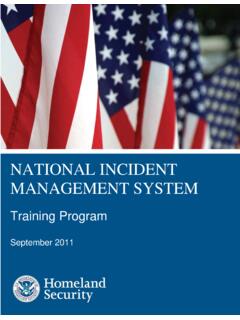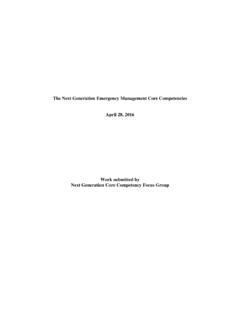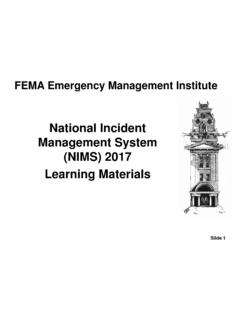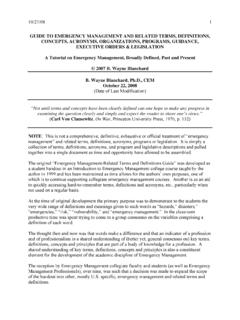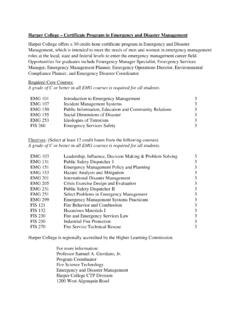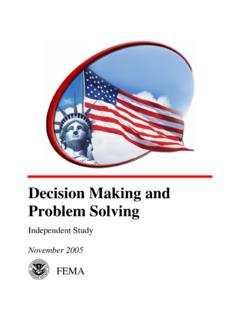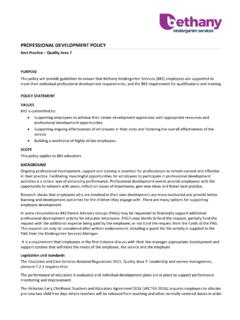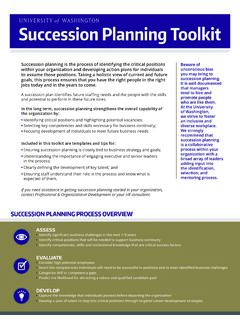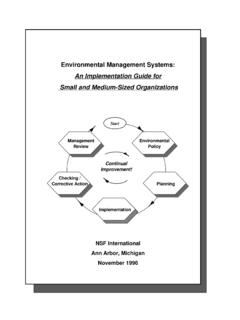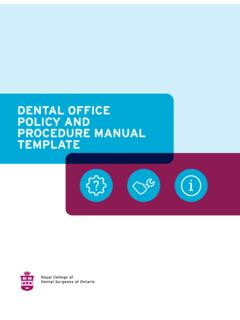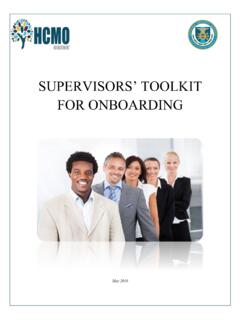Transcription of Session 4 PowerPoint - Emergency Management Institute
1 Stakeholders and Their Roles in Recovery Objectives: Local, state and federal government agencies Citizens (disaster victims). Media Business and Corporations University and research institutions Non-profit agencies and emergent community organizations Contractors Associations and collaborative partnerships Local, State and Federal Government Agencies and Officials Provision of aid Perception Contributions of government agencies Federal disaster declarations State disasters Local disasters National Emergency Management Association survey Local Emergency Manager Preparedness and response emphasis Coordinating damage assessments Local Emergency Management coordinator Local officials involved in disaster recovery Local Emergency managers and recovery duties Kartez and Faupel (1994).
2 Limited coordination hinders recovery efforts Long term recovery measures Planners, public works and economic development specialists Failure to involve local Emergency managers Local Government Departments and Officials Involved in Recovery When disasters strike, the entire community is affected Involvement of public officials Breadth of impact and roles of local officials Experience with emergencies versus disasters Provision of local technical assistance Role of elected officials Local, State and Federal Government Agencies and Officials Local government departments City manager Finance Public works Planning Police Fire Building inspector Local floodplain administrator City Manager Hiring contractors Reporting the status of the recovery effort to the general public.
3 Mayor and City Council Policy change Finance Documenting disaster expenditures Tracking of reimbursable costs Financial tracking of grant applications Public Works Post-Disaster damage assessment Restoring public water and sewer service Restoration of damaged infrastructure Planning Developing disaster recovery plan Developing pre and post-disaster grant applications Dissemination disaster assistance information Identification of suitable sites for post- disaster reconstruction Police and Fire Police Assisting individuals as needed Protecting public and private property Fire Initial search and rescue Suppressing fires Assisting with damage assessments Building Inspector and Local Floodplain Administrator Building inspector Damage assessment Determination of habitability and substantial damage Local floodplain administrator Assess the type of flood damages sustained Assess accuracy of Flood Insurance Rate Maps Notify homeowners of options Locally Elected Officials Representing constituents Advocates Distribution of assistance Political power Publicizing community needs Approving or denying proposed policy changes Locally elected officials Mayor City or Town Council members County Judge State Emergency Management General roles Establishing and maintaining an Emergency
4 Management program Coordination of state-wide training Advisor to Governor Provision of technical assistance and funding Coordination of post-disaster assistance Intermediary between local and federal government Local needs assessment State Emergency Management Assistance Direction, control and dispersal of resources Warning and communication Public information Training and technical assistance Sheltering and mass care Evacuation planning and implementation Law enforcement Damage assessments Hazardous materials Governor Emergency powers provision Post-disaster power Requesting federal disaster declarations Mobilize the National Guard Require evacuations Establish evacuation routes Establish curfews Possess or temporarily use private property Authorize the use of public funds to aid in recovery Suspend state statutes Enter into mutual aid agreements Delegate authority to State Director of Emergency Management Assuring
5 Disaster victims Lobbying State Legislature Order a state-wide hazards assessment Create a disaster trust fund Participate in the Emergency Management Assistance Compact Assess the level of state preparedness Evaluate recovery and mitigation programs Establish State Emergency Response Team Establish incentive programs Encourage teaching of disaster awareness in schools Pass state budgets that include Emergency Management duties Appropriate state funding Establish post-disaster recovery commission Adopt or amend state enabling legislation Lobbying members of Congress Federal Emergency Management Agency Federal Response Plan Federal Coordinating Officer Public information Congressional liaison Community liaison Outreach Donations Federal Emergency Management Agency Emergency support functions ESF 1 Transportation ESF 2 Communications ESF 3 Public works and engineering ESF 4 Fire fighting ESF 5 Information and planning ESF 6 Mass care ESF 7 Resource support ESF 8 Health and medical ESF 9 Urban search and rescue ESF 10 Hazardous materials ESF 11 Food ESF 12 Energy Federal Emergency Management Agency State Emergency Operations Center Disaster Field Office Disaster Recovery Operations Assess recovery needs Determine the level and type of damages Implement recovery
6 Programs Individual Assistance Public Assistance Hazard Mitigation Grant Program Federal Recovery Agencies Small Business Administration US Army Corps of Engineers Department of Housing and Urban development National Oceanographic and Atmospheric Administration Economic development Administration Limitations of Federal Response Plan Failure to coordinate recovery programs, funding sources or technical assistance Limited emphasis on pre and post-disaster planning at the state and local level Congress Disaster Relief Fund Supplemental appropriations Emergency aid to states Lobbying members of Congress Disasters as an entitlement (Platt 1999). Citizens (disaster victims).
7 Factors affecting the ability of disaster victims to recover Level of pre-disaster vulnerability Access to resources Level of pre-disaster preparedness Capability of those tasked with recovery assistance Citizens (disaster victims). Disaster victims may include: Homeowners Renters Homeless Business owner Employee Vacationer Local government official Citizens (disaster victims). Roles of citizens and disaster victims Assisting others Participating in a community or neighborhood- level disaster preparedness group Volunteering with disaster relief organizations Providing information to other victims or response and recovery agencies Investigating disaster assistance eligibility Applying for disaster recovery assistance Media Information dissemination techniques include.
8 Print Radio Television Internet Media Key factors Informing large segments of the population Eliciting strong emotions Inaccurate information dissemination Uncovering issues and weaknesses Additional issues Gaining an understanding of the recovery process Disaster recovery is a complex, relatively slow process Hindering the recovery process Altering the post-disaster salience of issues Media Local media Focus on local effects of the incident Concentrate on details Better relations with local authorities National media Short-term interest General accounts of the event Ask tough questions Media Television media Seek powerful visuals Use short sound bites Influenced by broadcast times and schedules Radio media Produce short reports Immediacy of information Strive to be the first to report the story Can quickly get authorities on the air One of the most essential disaster warning tools available Radio reports are highly
9 Perishable Media Print media Highly dependent on telephone linkages to transmit information Fewer time constraints than television or radio Provide more in-depth reporting Produce longer lasting archives and records of events Media Specific roles Supplying information and directions to the public Disseminating information on preparedness, recovery and mitigation following disasters Stimulating volunteerism and donations Stimulating increased participation among elected officials Disclosing the need for improvements in the disaster recovery delivery system Withholding information that could be counterproductive to the recovery effort Business and Corporations Contingency plan Identifying an alternative site of operations Storing vital documents Purchasing an alternative energy source Identifying alternative suppliers and transportation routes Encouraging employees to develop a home disaster preparedness kit Business and Corporations Disaster preparedness Size of business
10 Degree of past experience Commitment of top administrators Corporations Assets and workforce Resources at risk Business and Corporations Business interruption Loss of company revenue Temporary or permanent loss of work Economic impacts Becoming operational post-disaster Tangible example of recovery Returning to work Employers reaching out to disaster victims Providing direct assistance Business leader as advocate Ability to pursuade others Universities and Research Institutions Addressing complex research questions Research-practitioner divide Lack of applied research Failure to publicize findings Disconnect between research needs of practitioner and those conducted by scholar Universities and Research Institutions Roles Providing policy advice to practitioners Conducting research to identify problems or gaps in literature Post-disaster data collection and analysis Generating research reports or monographs Teaching Training and mentoring future Emergency Management professionals Universities and Research Institutions Growing influence Emergency Management courses and degree programs Hazards Management journals Research, training and information centers Non-profit Agencies and Emergent Organizations Services Provision of food and water Provision of clothing Mass
